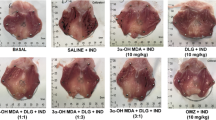Abstract
In the present study it was shown that, unlikely MK447, a known oxygen free radical compound, PGE2 is much less effective against indomethacin-induced G.I. ulcers than against ethanol damage. It seems likely that factors other than PG deficiency (such as oxygen free radicals), could be involved in the pathogenesis of NSAID-induced G.I. damage. Some compounds that can capture free radicals (aminopyrine, thiourea and its derivative, MK 447) or that inhibit the lipoxygenase pathway (MK 447, salicylazosulfapyridine, BW 755, benoxaprofen) are able to abolish indomethacin-induced G.I. damage. After irradiation with hydroxyl free radicals, indomethacin reacts with them to cause marked G.I. injury, even at a submaximal dose, one poorly ulcerogenic by itself. The above findings suggest that oxygen free radicals are one of the causal factors in the formation of NSAID-induced G.I. side effects.
Some of the data in this paper were presented at Fermo, August 31, 1984 (Advanced course on ‘oxygen and sulfur radicals in chemistry and medicine’) and at the 9th Iuphar International Congress of Pharmacology in London, July 30, 1984.
Similar content being viewed by others
References
J. R. Vane,Inhibition of prostaglandin synthesis as a mechanism of action for aspirin-like drugs, Nature (New Biol.),231, 232–235 (1971).
B.J.R. Whittle,Temporal relationship between cycloxygenase inhibition, as measured by prostacyclin biosynthesis, and the gastrointestinal damage by indomethacin in the rat, Gastroenterology,80, 94–98 (1981).
M.M. Cohen,Prevention of aspirin-induced fecal blood loss with oral prostaglandin E 2.Dose response studies in man, Prostaglandins (suppl.),21, 155–160 (1981).
A. Robert,An intestinal disease produced experimentally by a prostaglandin deficiency, Gastroenterology,69, 1045–1047 (1975).
B.J.R. Whittle,Relationship between prevention of rat gastric erosions and the inhibition of acid secretion by prostaglandins, Eur. J. Pharmacol.40, 233–239 (1976).
M. Ligumsky, E.M. Golanska, D.G. Hansen, G.L. Kaufmann Jr,Aspirin can inhibit gastric mucosal cyclo-oxygenase without causing lesions in rat, Gastroenterology84, 756–761 (1983).
F.A. Kuehl, Jr, J.T. Humes, M.L. Torchiana, E.A. Ham, R.W. Egan,Oxygen centered radicals in inflammatory process, In: ‘Advances in inflammatory research’ Ed. G. Weissman, B. Samuelson, R. Paoletti, Vol. 1o, pages 419–430, Raven Press, New York, 1979.
H. Satoh, I. Inada, T. Irata, Y. Maki,Indomethacin produces gastric antral ulcers in the refed rat, Gastroenterology81, 719–725 (1981).
K.O. Hiller, R.L. Wilson,Hydroxyl free radicals and anti-inflammatory drugs: biological inactivation studies and reaction rate constants, Biochem. Pharmacology32, 2109–2111 (1983).
D.J. Dunn,Multiple comparison using rank sums, Technometrics6, 241 (1964).
S. Daniotti andP. Del Soldato,Comparative studies of the effects of some antimuscarinic agents on gastric damage and pupillary reflex in the rat, Br. J. Pharmac.82, 305–307 (1984).
P. Del Soldato, A. Ghiorzi, E. Cereda andA. Donetti,Cimetidine, ranitidine and mifentidine in specific gastric and duodenal ulcer models, Pharmacology30, 45–59 (1985).
G. Cohen, R.E. Heikkila, B. Allis, F. Cabbat, D. Dembiec Mac Nemee, C. Mytilinedou andB. Winston,Destruction of sympathetic nerve terminals by 6 hydroxydopamine protection by 1 phenyl-3-(2-thiazolyn)-2 thiourea, diethyl-dithio-carbamate, methimazole, cysteamine, ethanol and n-butanol, J. Pharmacol. Exp. Ther.199, 336–351 (1976).
K.D. Rainsford,Mechanisms of gastrointestinal ulceration by non steroidal antinflammatory analgesic drugs, In: ‘Advances in inflammation research’, Ed. Rainsford K.D., Velo, G.P., Vol. 6, pages 51–64, Raven Press, New York, 1984.
S.N. Pennington andC.P. Smith,Indomethacin stimulation of lipid peroxidation and chemiluminescence in rat liver microsones, Lipids13, 636–643 (1979).
T.L. Dormandy,An approach to free radicals, Lancetii, 1010–1014, (1983).
F. Burka andR.J. Flower,Effects of modulators of arachidonic acid metabolism on the synthesis and release of slow-reacting substances of anaphylaxis, Br. J. Pharmacol.65, 35–41 (1979).
H.R. Morris, P.J. Piper, G.W. Taylor andJ.R. Tippins,The role of arachidonate lipoxygenase in the release of SRS-A from guinea pig chopped lung, Prostaglandins19, 371–383 (1980).
J.R. Walker, J.R. Boot, B. Cox andW. Dawson,Inhibition of the release of SRS-A by inhibitors of lipoxygenase activity, J. Pharmacol.32, 866–867 (1980).
J. Baumann, F.V. Bruchausen andG. Wurm,Flavonoid and related compounds as inhibitors of arachidonic and peroxidation, Prostaglandins20, 627–639 (1980).
J.C. Sircar, C.F. Schwender andM.E. Carethers,Inhibition of soybean lipoxygenase by sulphasalazine and 5 aminosalicylic acid: a possible mode of action in ulcerative colitis, Biochem. Pharmacol.32, 170–171 (1983).
G.J. Blackwell, R.J. Flower, F.P. Nijkamp andJ.R. Vane,Phospholipase A 2 activity of guinea-pig isolated perfused lungs: stimulation and inhibition by antiinflammatory steroids, Br. J. Pharmac.62, 79–89 (1978).
P. Del Soldato, D. Foschi, L. Varin andS. Daniotti,Indomethacin-induced intestinal ulcers in rats: effects of salicylazosulfapyridine and dexamethasone, Agents and Actions,16, 393–396 (1985).
K.D. Rainsford,An analysis of the gastro-intestinal side effects of non-steroidal anti-inflammatory drugs, with particular reference to comparative studies in man and laboratory species. Rheumatol. Int.2, 1–10 (1982).
Author information
Authors and Affiliations
Rights and permissions
About this article
Cite this article
Del Soldato, P., Foschi, D., Benoni, G. et al. Oxygen free radicals interact with indomethacin to cause gastrointestinal injury. Agents and Actions 17, 484–488 (1986). https://doi.org/10.1007/BF01965518
Received:
Accepted:
Issue Date:
DOI: https://doi.org/10.1007/BF01965518




